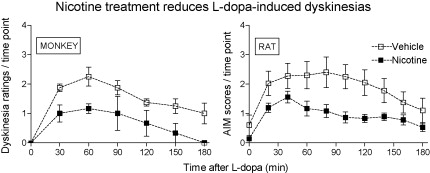Citation
Quik, M., Huang, L. Z., Parameswaran, N., Bordia, T., Campos, C., & Perez, X. A. (2009). Multiple roles for nicotine in Parkinson’s disease. Biochemical pharmacology, 78(7), 677-685.
Abstract
There exists a remarkable diversity of neurotransmitter compounds in the striatum, a pivotal brain region in the pathology of Parkinson’s disease, a movement disorder characterized by rigidity, tremor and bradykinesia. The striatal dopaminergic system, which is particularly vulnerable to neurodegeneration in this disorder, appears to be the major contributor to these motor problems. However, numerous other neurotransmitter systems in the striatum most likely also play a significant role, including the nicotinic cholinergic system. Indeed, there is an extensive anatomical overlap between dopaminergic and cholinergic neurons, and acetylcholine is well known to modulate striatal dopamine release both in vitro and in vivo. Nicotine, a drug that stimulates nicotinic acetylcholine receptors (nAChRs), influences several functions relevant to Parkinson’s disease. Extensive studies in parkinsonian animals show that nicotine protects against nigrostriatal damage, findings that may explain the well-established decline in Parkinson’s disease incidence with tobacco use. In addition, recent work shows that nicotine reduces l-dopa-induced abnormal involuntary movements, a debilitating complication of l-dopa therapy for Parkinson’s disease. These combined observations suggest that nAChR stimulation may represent a useful treatment strategy for Parkinson’s disease for neuroprotection and symptomatic treatment. Importantly, only selective nAChR subtypes are present in the striatum including the α4β2*, α6β2* and α7 nAChR populations. Treatment with nAChR ligands directed to these subtypes may thus yield optimal therapeutic benefit for Parkinson’s disease, with a minimum of adverse side effects.
Keywords: L-Dopa-induced dyskinesias, Neuroprotection, Nicotine, Nicotinic, Nigrostriatal, Parkinson’s disease
Graphical abstract



